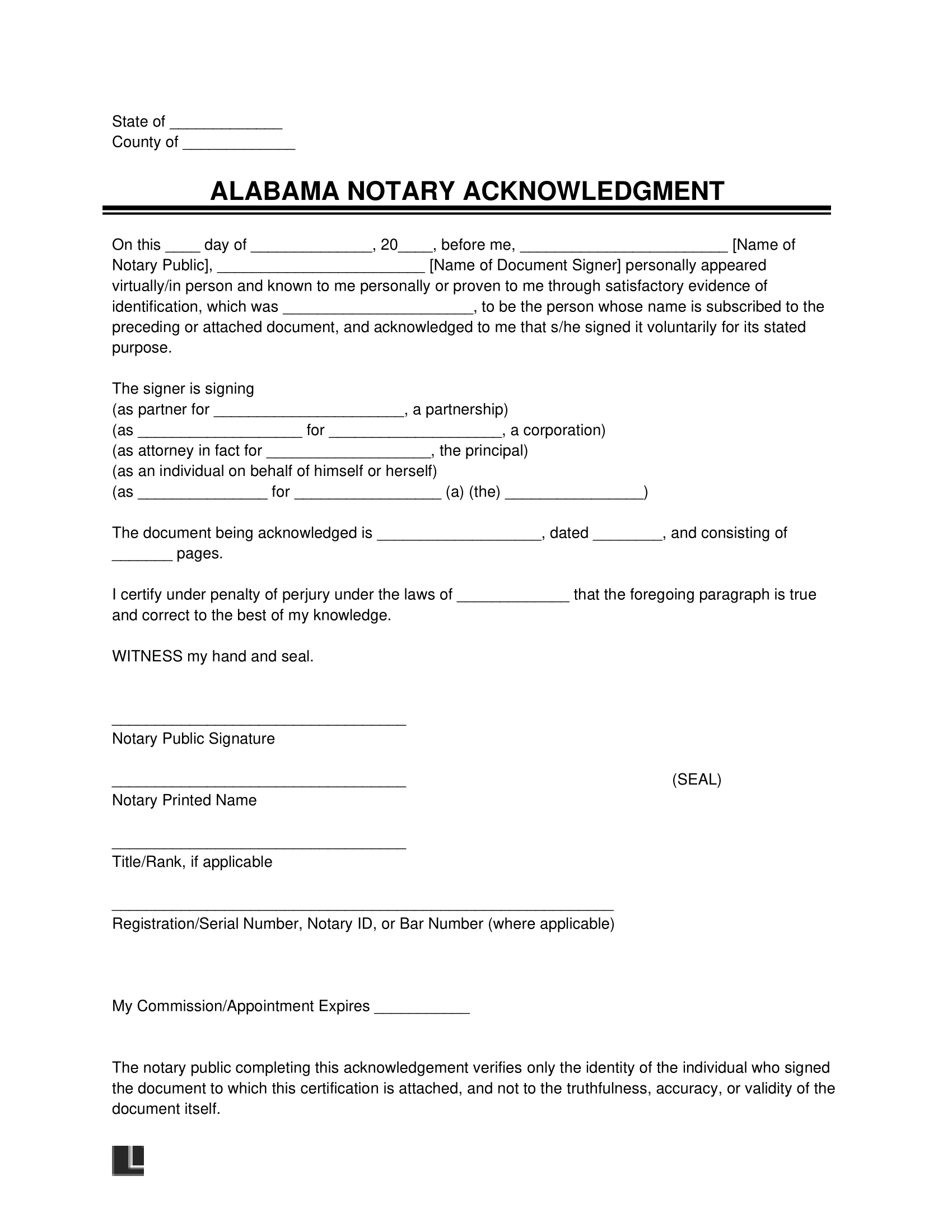An Alabama notary acknowledgment form is a legal document used to verify the authenticity of signatures on various legal instruments, contracts, or agreements. This form serves as an official certification that the individual signing the document did so in the presence of a notary public and that their identity was verified at the time of signing.
In cases where the notary public does not know them personally, the signing party must prove their identity by presenting at least one government-issued photo ID featuring their signature. Notaries, appointed and commissioned by probate judges, sign and stamp their official State seal to the document, making it legally binding.
Legal Considerations
Statute: Code of Alabama, Title 35, Chapter 4, Article 2.
Form of Acknowledgment: Under AL Code § 35-4-29, the acknowledgment must include a confirmation of the voluntary execution of the document after being informed of its contents, along with the name of the notary, the state, the county, and the date.
Notary Term of Commission: Four years (AL Code § 36-20-70).
Notary Handbook: The Secretary of State’s Handbook for Notaries Public is a valuable resource for notaries in the state.
Is Online Notarization Legal in Alabama?
Yes, starting with July 1, 2021, Senate Bill 275 allows the remote signing of documents via two-way audio and video communication, provided the notary is physically in the state.
According to AL Code § 36-20-73.1, the identity of the signing party must be verified by the notary’s personal knowledge or by presenting two valid government-issued IDs.
The communication recording during remote notarization should include specific details, such as the date and time of the notarial act, document details, notary’s physical location attestation, method of identity verification, and clear images of the IDs and the act of signing.
Fees for online notarization start at $5 for each acknowledgment and jurat.
Actions taken before July 1, 2021, allowing remote notarization under the Emergency Management Act of 1955, Chapter 9 of Title 31, are confirmed. However, remote notarization cannot be used for absentee ballot applications or voting-related purposes. Intentional fraudulent violations result in a Class C misdemeanor.
How to Notarize
Step 1 – Find a Notary Public
You can search online to locate licensed notaries in the state. Additionally, inquire at your local bank (Regions Bank, for instance) or credit union, UPS Stores, FedEx Offices, or local businesses.
Some libraries may also offer free notary services, typically available for both library cardholders and the general public. Always consider calling ahead to ensure the notary’s availability before visiting.
A notary public has the authority to charge $10 for each signature or notarial act performed, as mandated by AL Code § 36-20-74. Additionally, if the notary travels to meet you, they may apply supplementary fees to cover travel expenses. State laws do not establish specific limits on the travel fees that a notary can charge.
Step 2 – Bring the Document
Bring the document along with any necessary witnesses to the notary’s office or chosen location for the process. Identification plays a crucial role in this step, so ensure you possess one of the following government-issued IDs displaying both a photo and signature: driver’s license, state-issued identity card (from any U.S. state), or U.S. Passport.
The notary will verify your identity by cross-referencing your photo ID with your appearance and the name on the document, validating the authenticity of the signing.
Step 3 – Sign the Form
In the case of documents requiring acknowledgment, signatures may already be present beforehand, and authenticity will need to be verified. Otherwise, individuals need to sign before the notary. Upon the notary’s examination of the document and your government-issued identification, signing takes place in their presence.
Following the document’s signing, parties must confirm their voluntary signature. The notary will then add their signature and expiration date of their certification and include their stamp or seal on the form. Once this process concludes, the notarization is complete, ensuring compliance with state regulations and allowing the parties to depart with their legally valid documents.
How to Verify a Notary
- Use the Notary Public Records to access the Secretary of State’s website.
- Below the “Notaries Public Search Options” heading, you’ll find various search options. Choose “by Name” to search for a notary using their first and/or last name and designate a county, notary type, and status to narrow down your search. Click on “Search” to proceed and obtain refined search results.
- Opt for “by Bonding Company” if you wish to search for a notary associated with a particular bonding company. Enter the name of the bonding company and click on “Search” to submit.
- To search for notaries commissioned on a specific date, select “by Commission Date.” Beneath the entry field, utilize the drop-down menus to specify a county and/or notary type. When ready, click on “Search” to submit your query.
- Choose the “by Expiration Date” search option to find notaries whose commissions expire on a particular date. Use the drop-down menus to further refine your search by specifying a county and notary type. Click on “Search” to proceed and obtain the relevant results.
- Once you’ve submitted your search information, you’ll be directed to a webpage displaying a list of notaries matching your search criteria. Click on a notary’s name to access additional details.
How to Write (for Notary)
- Download a notary acknowledgment form in PDF or Word format.
- Enter the county of the notarization, followed by the name of the person being acknowledged. Complete the date by entering the day, month, and year in the remaining three spaces provided.
- Include your notary seal, signature, printed name, title, and commission expiration date in the designated fields.
- Keep a copy of the document for your records and hand over the original to the signer.


